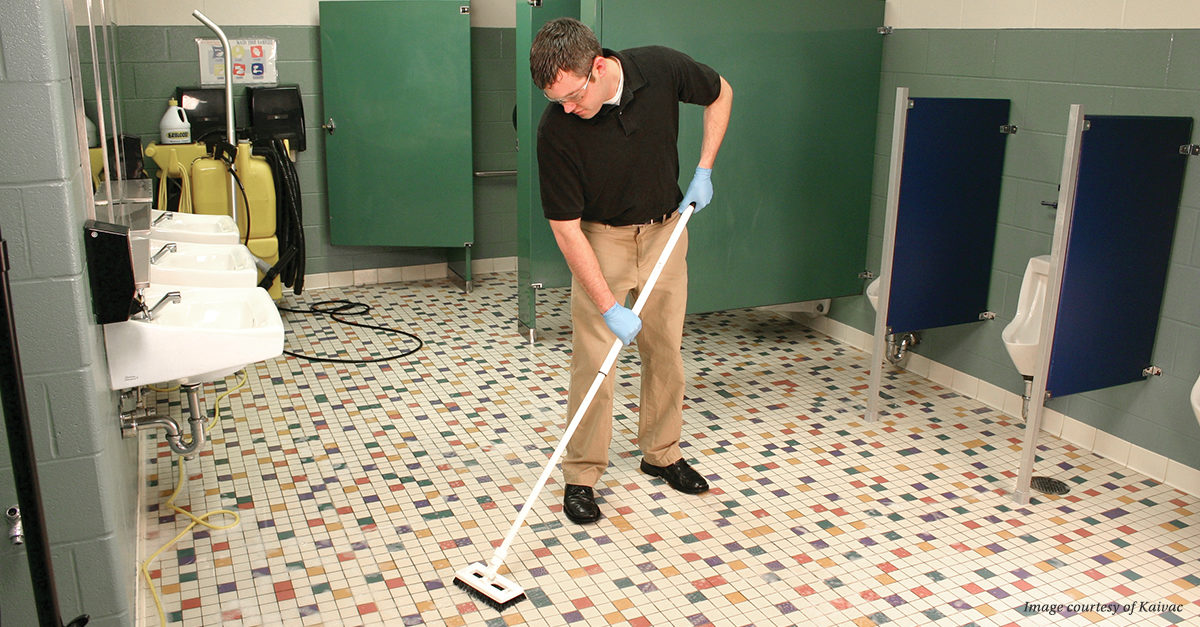Significant wear-and-tear can make cleaning an outdated floor difficult—and in some cases, near impossible.
However, to correctly price new job bids and avoid underestimating the materials involved, it’s important to know how commercial flooring materials age.
In addition, it’s equally important to know how to keep them from aging. And while many of your clients may understand the importance of regular maintenance, periodic special treatments may prove to be a harder sell—making it even more crucial that you understand what treatments will best restore a floor to avoid promising impossible results to both new and existing clients.
Find out below what special services can help to keep carpet, wood, laminate, and linoleum in top shape as they age and experience wear and tear.
Carpet
Like many materials, a carpet’s lifecycle depends on the environment it’s in. Carpet in a high-traffic area will likely age faster; however, with proper care, carpet can have a useable life span of 10 or more years, at least in certain environments, according to the Carpet and Rug Institute (CRI), a nonprofit carpet industry trade group.
Generally, different environments require different cleaning cycles. “A restaurant, for example, might require you to deep clean once a month,” CRI President Joe Yarbrough says. “In a dentist’s office or doctor’s waiting room, you might do an annual deep cleaning.”
Whether it’s monthly, yearly or another time period, deep cleaning treatments are a key part of prolonging a carpet’s life.
Jotham Hatch, director of training at carpet and upholstery cleaner Chem-Dry—which has 3,500 franchises in 47 countries and throughout the United States—compares carpet maintenance to changing the oil in your car. “The idea is to stay on top of it before it becomes a problem and causes permanent traffic lanes or fading,” he says. “If you’re starting to see soil levels build up, you’ve waited a little too long.”
Periodic carpet treatments can vary based on the material’s appearance, and can range from simple shampooing to using dry foam, another material, or a combination of items and methods.
Generally, Hatch recommends using a hot water extraction process on carpets, potentially with a mild detergent or crystal clear carbonation solution. “The idea is to suspend the soil, often yearly, with a water-based cleaning solution,” Hatch says. “You often use pre-conditioners to soften up any dirt.”
With this method, dirt is extracted using a spinning power device. The key, Hatch says, is to avoid leaving any residue on the carpet, which could create a breeding ground for bacteria and mold.
If clients aren’t willing to pay for periodic cleaning treatments for the entire building or a whole room, they may be open to a less costly option: treating certain parts of a carpet.
If building owners or regular maintenance crews spot-treat the carpet in between deep cleanings with store-bought spot treatments, it’s important to rinse the area thoroughly to avoid leaving a soapy residue, which can cause areas to discolor, Hatch says. “Some really struggle with reappearing spots that, after a cleaning, over time, comes back,” he says. “A spot spray can clean up well, but if there’s a residue left, as people walk by, it gets dirtier and dirtier earlier than the rest of the carpet.”
Wood
Wood flooring can have an exceptional lifespan. In fact, it’s not unusual to see commercial buildings with wood floors that are 100 years or older, according to Builder magazine.
As such, the material can be a good choice for high-traffic facilities. However, in addition to regular sweeping, mopping, and other cleaning methods, wood flooring also needs to periodically undergo more aggressive procedures, including stripping and refinishing the floor when daily or weekly maintenance won’t restore its luster.
Clients typically need to redo the process every few years, says Matt Madeoy, CEO and founder of Washington-based commercial and residential cleaning provider Sound Cleaning Resources. “I haven’t seen many people do it every year,” he says. “The sealer tends to last longer than that.”
However, when it comes time to refinish the floor, service providers need to be careful, according to Jim Selway, an advisor to the Institute of Inspection Cleaning and Restoration Certification (IICRC) who previously owned a wood flooring distributorship and a contract cleaning business in York, PA. If, for example, you didn’t ensure the floor was dust- and debris-free after prepping it, the floor could be left with dimples once it dries—indicating you’ve spent serious money on a job that now needs to be redone.
“Five gallons of finish is close to or over US$500,” Selway says. “If you do a gym with 10 pails of finish, and the job goes belly up, you’re in for some big losses.”
In some cases, completely refinishing the floor may not be necessary.
Scratches, nicks, or similar damage to the wood, in most cases, need to be sanded down and refinished. However, wood floors with light scuffs, grime, or other residue can often be machine cleaned and polished to remove the problematic marks. Hardwood floors may also benefit from adding a urethane maintenance coating, which restores the beauty of the wood and makes it more durable, Madeoy says.
Flooring owners who thought more expensive work was in store may be pleased to find out they can remove some imperfections with a cleaning service.
“You don’t always have to replace the whole floor,” Selway says. “When you work on wood floors, you work on the removability and reparability.”
Laminate
Because laminate flooring is durable, easy to install, priced less than wood floor materials, and also typically requires less maintenance (thanks to its wear layer, which can contain melamine resin and aluminum oxide that help to resist stains and gouges, according to the World Floor Covering Association), it can be a cost-effective option for commercial spaces.
In a commercial setting, laminate can last five to 10 years, if cared for correctly, according to Joe Gaffney, operational performance manager at cleaning service provider COIT, which has franchises in the United States, Canada, and Thailand. However, Sound Cleaning floor tech Bill Chalmers says installation can play a part in how it ages.
“The laminate installation methods aren’t always the same,” Chalmers says. “The floors tend to have space underneath, so you’re always worried about moisture getting under it and sitting there. If it gets up through the sealer, the floor could eventually discolor.”
Cleaning service providers may need to work with the client’s regular cleaning and maintenance providers to ensure they understand how to clean laminate—which includes using water sparingly—or periodic treatments may not be of much help.
Madeoy provides some tips on how to take care with laminate: “You have to use water, but almost mix it on the floor so you’re still getting a cleaning effect but not letting it penetrate into the gaps between the boards at all.”
Once laminate floors are scratched or otherwise damaged, they may need to be replaced.
COIT Commercial Manager Ed Glinden says there really isn’t a way to correct damage to laminate. “It’s not like wood,” he says. “You can’t sand it down and refinish laminate.”
Linoleum
Although linoleum’s all-natural-ingredient and water-resistant surface is easy to clean, building a set schedule for periodic linoleum polishing or spray buffing into a cleaning services package can help extend the floor’s life and appearance.
“We see linoleum all the time—it’s still pretty common because it’s durable,” Madeoy says. “Most [commercial owners], however, don’t do maintenance on a regular basis.”
Deep cleaning can include coating the floor with a stripping solution, machine scrubbing it, and removing the stripping solution residue with a wet vacuum or mop before rinsing the floor with clean water.
Commercial floors often also undergo an annual wax treatment, depending on the owner’s budget, the floor’s wear, and how much shine the client wants, Madeoy says. The linoleum is stripped down to its original surface and three to five coats of wax are applied.
“If the floor isn’t stripped on a regular basis, you’re just putting new wax over old wax,” he says. “The old wax will discolor over time, but linoleum is so resilient when maintained properly.”
Madeoy also recommends applying a wax treatment without necessarily stripping the floor every one to four months. The floor is first scrubbed to remove any ground-in dirt or debris, one to two coats of wax are applied, and a floor polisher is used to finish the look.
“Linoleum is very economical because it allows you, whether you have a showroom or a medical office or school, to prolong the life of the floor with treatment,” Madeoy says. “With carpet, you can clean it a couple of times a year, but you may have to tear it out and replace it next year. We’re cleaning [linoleum] floors that are 50 to 60 years old.”
Rubber
Rubber flooring can have a long life span and is a popular choice in certain types of buildings—including populated environments, such as health care facilities, because it provides a cushioned, scuff-resistant surface, according to Interiors & Sources magazine.
Steve Chase, president of gym and recreation flooring provider Fitness Flooring, estimates a rubber floor with thick tiles can last 20 to 30 years, in part due to its cleaning capabilities.
Monthly or bimonthly, depending on use, Chase recommends using a somewhat aggressive cleaning method, such as an auto scrubbing machine with a soft nylon brush or cleaning pad, particularly for recycled rubber floors where small voids between the reground rubber fibers can let dirt get beneath the floor’s surface.
If the commercial space owner or tenant has applied the sealant that was provided by its rubber floor manufacturer after installation, lightly buffing the floor once or twice a year can help keep up the shine, Chase says.
Small problem areas should be fairly easy to clean. “For things like black heel marks and tar, rubbing mineral spirits on the immediate area will clean it up with just some hand scrubbing,” Chase says.
Past the Point of Repair
In some cases, no matter how much regular—and periodic—maintenance you perform, a floor will age beyond the point when you can restore its luster. This may initially seem like a setback; but for the savvy service provider, an almost-out-of-commission floor can be an opportunity to serve as a proactive partner to your client.
Consider planning an annual meeting or other regular update to check in with clients about their floors’ status, which can help to keep them informed about floor condition as it changes—and avoid any unrealistic expectations they may have about how cleaning services can maintain and restore an aging floor.
“We always go in with a consultant consciousness,” Gaffney from COIT says. “You’ve got to be on top of it, in terms of knowing you can only do so much for a floor, and letting the client know, ‘This is where we are.’”
If a floor has reached the end of its lifecycle, initiate a conversation with your client about replacement before regular maintenance fails to show much effect. Proactively approaching your client about the floor’s condition will allow you to offer helpful material recommendations and tips for ongoing care, which can strengthen your client relationship and better prepare you to secure a cleaning contract for the new floor.
“Clients might call us to come in and maintain carpet on a quarterly basis, but it’s also what they do with the other 90 days that matters,” Gaffney says. “Whether it’s proper procedures, maintenance on vacuuming units, or how they are cleaning up spots or stains—they really appreciate us opening their eyes to improve their investment.”



